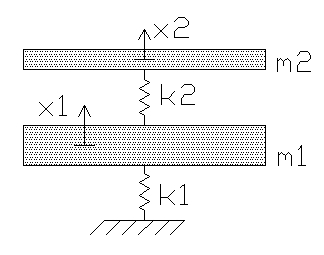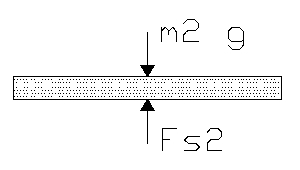Coupled Oscillator: Coupled Mass-Spring System with Input: Difference between revisions
Jump to navigation
Jump to search
No edit summary |
No edit summary |
||
| Line 66: | Line 66: | ||
\Rightarrow\ \ddot{x}_1 = \frac{-k_1}{m_1} \, x_1 + \frac{k_2}{m_1} \, x_2 - g + \frac{F}{m_1} | \Rightarrow\ \ddot{x}_1 = \frac{-k_1}{m_1} \, x_1 + \frac{k_2}{m_1} \, x_2 - g + \frac{F}{m_1} | ||
</math> | </math> | ||
==State Space Equation== | ==State Space Equation== | ||
Revision as of 20:26, 18 November 2009
Setup State Space Equation
Problem Statement
Find an input function such that the lower mass, , is stationary in the steady state. Find the equation of motion for the upper mass, .
The use of one spring between the masses is just a simplification of a multi-spring system, so the possibility of being off-kilter is neglected and just the vertical forces are considered.

Initial Conditions and Values
Let the initial conditions be zero for the time being.
Force Equations


Sum of the forces in the x direction yields
For
Since
And for
Where is the input force
State Space Equation
The general form of the state equation is
Where denotes a matrix and denotes a vector.
Let , , , and be the state variables, then